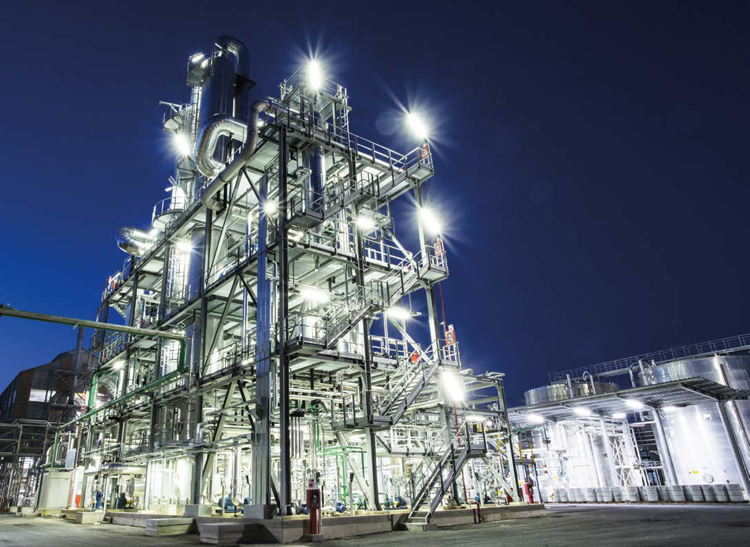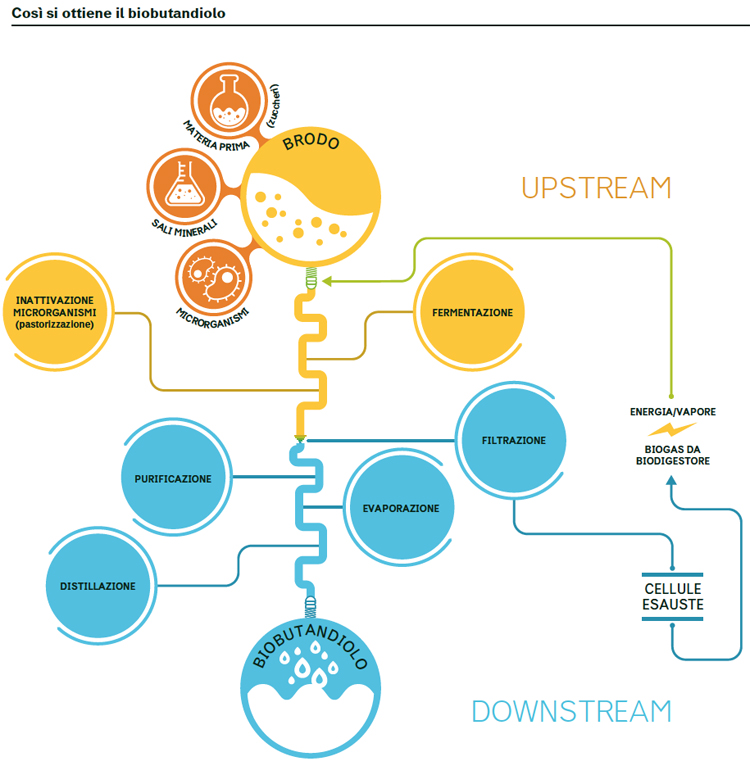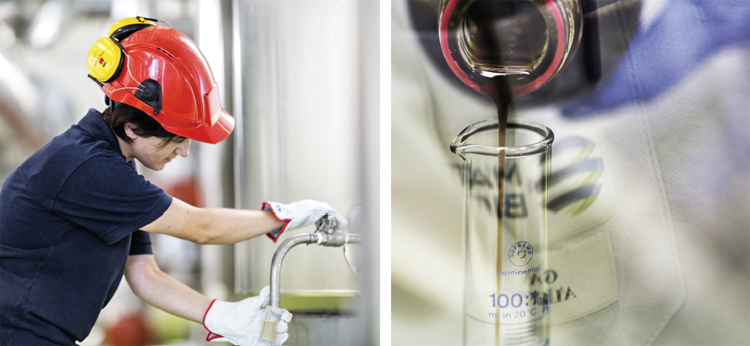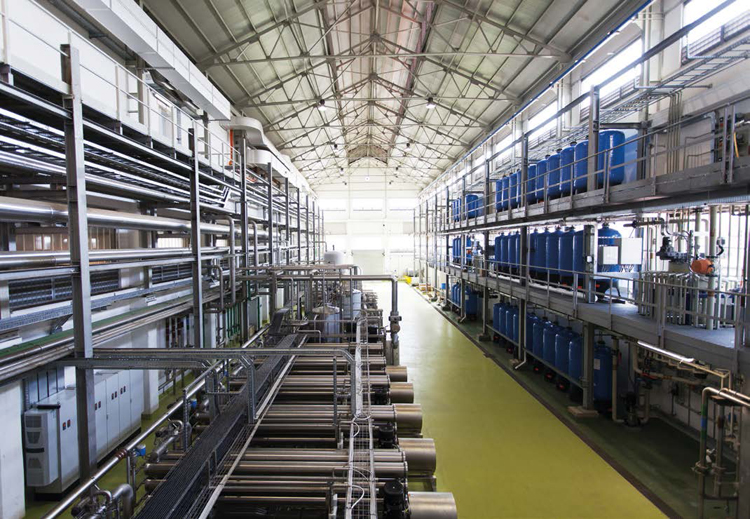C4H10O2. This is the formula of 1,4-Butanediol, a chemical compound derived from butane, a colourless gas which is obtained through fractional distillation of oil and natural gas. It is a fossil-derived liquid, widely used as a solvent and for the production of plastics, elastic fibres – such as spandex – and polyurethan. It is also used in the pharmaceutical industry, as well as a recreational drug, under the name of “One Comma Four,” which is the chemical bond between oxygen and hydrogen. Most importantly, butanediol is a real treasure for industry.
Currently, the total value of the global industrial market for 1,4-Bdo – as it is called in the sector – is estimated at around €3.5 million. The main producers of Bdo from fossil fuels are the big world chemical groups: from German Basf to Dairen in Taiwan, down to American Lyondell, Isp and DuPont. Hundreds of thousands of tonnes of oil are used every year to produce it; quite a considerable amount for a chemical product.
For this reason, alternative formulae have been researched for years, which could synthetize Bdo from non-fossil sources. Big chemical companies, such as the multinational Basf, have tried in vain to use alternative processes, without being able to reach industrial scale production.
However, non-fossil 1,4-Butanediol is about to enter the market. On 30th September 2016, Novamont, a pioneer and world leader in the development of bioplastics and bioproducts, opened the first industrial plant ever which will produce bio-butanediol, through its subsidiary Mater-Biotech. The plant is in Bottrighe, in the Adria industrial area, in the province of Rovigo. The bio-butanediol will be produced without a single drop of oil, allowing for a saving of over 50% on CO2 emissions. This represents a new record in Italian green chemistry, which is proving incredibly active.
But what is replacing oil? “Novamont has started producing 1,4-Bdo directly from sugar, using a technology developed by Genomatica – a leader in bioengineering innovation – which was integrated by our chemical know-how,” explains Luigi Capuzzi, head of research at Novamont.

The base of this revolution is a kind of escherichia-coli (e.ßcoli), a small common bacterium that lives in the intestine of warm-blooded animals. It is an abundant resource: every day we expel from the last tract of our intestine up to 100 billion bacteria. The only bacterium capable of synthetising sugar into butanediol in one single step through its digestion was selected out of the thousand types that were synthetically produced and tested in laboratories. It is the only one that can operate the same way as a completely organic and renewable nano-refinery.
The process was discovered in 2008 in San Diego, California, by the synthetic biologist Christophe Schilling, CEO and founder of Genomatica, who is described by Scientific American as one the most brilliant minds in the sector. “We have genetically engineered an organism that needs secreting this kind of product in order to grow” Shilling said in a recent interview. “ The interest of e.coli is in line with our interest. The more it produces, the more it grows.”
Schilling’s company has worked for years to genetically engineer an e.coli capable of developing a digestive system that could synthetize sugar at temperatures around 40 °C. “In nature, no bacteria can do it spontaneously. Genomatica is the only company that discovered this,” explains Luigi Capuzzi, head of research at Novamont. “And we are the only ones who have used it on a large scale, making bio-butanediol competitive, even in spite of the current low oil price.”
The strategic advantage of Novamont lies in the direct procedure of transformation. Indeed there are other processes that transform butanediol from renewable sources, but they are not equally efficient per cost unit. “At the moment it is already possible to transform sugar into succinic acid using bacteria,” Capuzzi specifies. “At a later stage, this acid is transformed into 1,4-Bdo through chemical hydrogenation. But the competitive and environmental advantage of our product, compared to other non-fossil Bdo, lies in our one-step process,” with significant savings in terms of costs, energy and emissions.

All-Round Sustainability
The sustainability of the “made in Novamont” bio-butanediol is not exclusively related to the product, which certainly reduces the use of oil, but also to the process. The Bottrighe plant, where bio-butanediol is produced, is truly excellent and a great example of Italian green chemistry.
The Mater-Biotech bio-technological plant has been designed in a way that it can re-use the process’ byproducts for its own energy needs, thus optimizing the life cycle of the entire productive flow. It was created in less than four years replacing an old plant that had closed in 2006 and that used to produce lysine (a polar amino acid which is used as a food supplement). The plant will be able to produce 30,000 tonnes of butanediol per year, providing employment – at full capacity – to 70 people, and creating a spin-off of about 180-200 workers. “We acquired the structure, completely regenerating the fermentation part, which was in good conditions, but we had to build the downstream part from scratch, as lysine is a solid product, an aminoacid that purifies through crystallization. 1,4-Bdo is a liquid product which purifies through distillation and for this reason it required an ad-hoc plant. What really makes us proud is the fact that we could give a new start to both the plant and the workers,” Capuzzi explains.
The plant, which is quite small compared to other refineries of fossil fuel-derived Bdo, is part of the Novamont integrated biorefinery project. This is currently made up of six interconnected sites and four new technologies: the bio-Bdo, the system of starch complex formation, the process for biodegradable polyesters and finally the acid production system (azelaic acid and natural oil-derived pelargonic acid).
The research managers show their satisfaction and their pride at having built such a plant in Italy in record time. “We put together the idea of growing the e.coli bacteria and our capacity to move our research projects to an industrial scale,” Capuzzi explains, “combining the selected microorganisms, the engineered fermentation process, and the downstream part, so as to obtain an extremely pure product, which is in all aspects similar to the one derived from fossil sources.”

A Circular Production
How to make the production process of 1,4-Bdo even greener and more circular? At the moment, the production of butanediol uses “digestion” of a glucose syrup produced by Cargill. “To produce a kilo of butanediol we need two kilos of sugar according to the process’ stoichiometry,” Capuzzi explains.
The problem is that sugar comes from food crops. For this reason, Novamont research is working towards the use of sugar derived from ligno-cellulosic biomass, coming from crops on marginal terrains that are not used for agriculture.
As of today, the most advanced crop at an experimental level is thistle, which also has the benefit of being a double dividend product. One the one hand, an oil obtained from thistle seeds can be used by Novamont in its Porto Torres plant, in the process that transform it into azelaic acid (C9H16O4, the acid component in the polyesters that are used in the mater-Bi®, while the alcoholic component is butanediol itself). On the other hand, the thistle stem can be used as ligno-cellulosic mass for Bdo.
These two elements together are the base of Novamont bioplastics. “We hope to use our 1,4-Bdo in our bioplastics, so as to obtain products with high-environmental performances in a restricted production cycle, in full respect of the rules of bioeconomy,” Capuzzi concludes. Novamont’s interest in investing in thistle crops is hardly surprising, as it proves fundamental in obtaining second generation sugars, azelaic acid, as well as a series of proteins for animal feeding.
This way the bio-integral cycle of the product is completed. A product which is derived from a crop growing on non irrigated terrains unfit for agriculture, and which is realized in a plant that can use and recover outputs though a synthetic bacterium. All this happens without using a single drop of oil.
The future of chemistry (be it Italian or not) is green and circular.

Info


